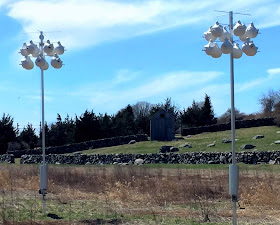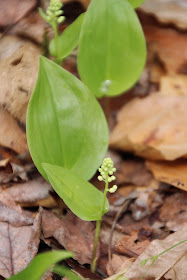by Beth Sullivan
It has begun! Those of you who have
followed this blog for several years, know of my commitment to (some
say obsession with) my Purple Martins on Knox Preserve. You can catch up on recent history in earlier posts, here and here.
There are dedicated websites to
document the Martins’ movement north, and it is always amazing the
consistency that governs these migrations. For all of us, spring
seemed to have gotten off to a very slow start, but by mid-April we
were getting reports that the Martin scouts had been spotted in the
area. We got up the first gourd system at Knox on April 21 and were
immediately rewarded with several birds all checking out the best
real estate. Established pairs tend to return to the same colonies
each year, and the young, from previous years, get second dibs or
move on to expanded colonies. The second set of gourds went up the
following week. It was encouraging because at that point in time, it
appeared that spring might actually stick around: there were flies,
butterflies and other insects present in the air over the fields.
 |
| After being washed, marked, and stored for the winter the gourds were ready to hang in mid-April. |
 |
| Adult males get first choice for nests |
Purple Martins move in
I have been keeping watch for the
last couple of weeks, and while the weather recently has not been
optimal for flying insects or for anything flying, the birds are
returning and are beginning to put their claims on various gourds.
If you sit on the bench on the hill at Knox, and have a good pair of
binoculars, you can actually follow their antics and aerial
acrobatics. You will also see that there are House Sparrows also
trying to get established in the gourds as well. Part of my job as
landlord is to do periodic housekeeping when I will lower the gourds
and remove the nests of the Sparrows. It is very easy to tell them
apart: Martin nests are lovely and neat and lined with green leaves,
prior to egg laying. House Sparrows fill up the entire gourd with a
tangled mess of straw and debris which needs to be pulled out. In
persistent cases we will close the hole up to keep them out, but we
always fear they will be so aggressive they will fight and even kill
a Martin, to displace it. Please: Do NOT encourage the proliferation
of House Sparrows in your bird houses. As they are invasive and
non-native; they are not protected and we are all encouraged to
remove them.
 |
| House Sparrows tend to jam tons of straw into a cavity and their eggs are speckled. |
 |
| Purple Martin nests less crowded and neater with pure white eggs. |
New apartment house for Purple Martins
We do have a wonderful new addition
this year. Through a couple of fortuitous connections between Purple
Martin landlords, we were offered a complete Martin house set up from
Menunkatuck Audubon. This Audubon group supports a number of great
projects farther down the CT coast. Most notably, they support and
monitor the Martin houses at Hammonasset State Park. They also
monitor several Osprey nests, including one with a camera. You can find it here. We connected with landlords Lorrie and Terry Shaw and met them at
Hammonasset one cold day in early April. They were in the process of
updating their Martin housing so all would be the same style and
function, making it easier for their volunteers to monitor. They
had not one, but two, beautiful complete set ups for us to bring back
to Avalonia territory. These are the more well-known style of
apartment house nests but with all the high quality updates of easy
winch and pulley system and easy to clean nest trays. We put up
one at the Wequetequock Cove Preserve on Palmer Neck Road on the way
to Barn Island. It is an ideal site, open fields yet near people
and water, but because there are no other colonies in the area, it
will be more of a challenge to attract the birds right away. We
added a couple of decoy birds to attract attention.
It is arrival
time right now. The younger birds will be a bit later and will be
looking for new colonies. Our Knox preserve colony is active but we
have not yet seen Martins at our new site, just House Sparrows. They
will not be allowed to occupy this new abode. If you drive by, look
for the house in the south field. There is room to pull over and
spend a few minutes looking. The fields have been home to Bobolinks
in the past. The wet areas have had Glossy Ibis and shorebirds
recently and many Red Winged Blackbirds call from the grasses where
they will nest. This is a known hot spot for birds in all seasons.
Let’s hope the Martins will find the new home inviting and we can
add to the species list.
We haven’t yet decided on the best
place for house number two. We’ll see how this one does. Many
thanks to the Menunkatuck Audubon Society for their amazing gift to
us and the Purple Martins.
 |
| The new house is up on Wequetequock Cove Preserve. |
 |
| Two sets of gourdes are up at Knox Preserve and already have residents. |
 |
| Hopefully ours will full up soon like this one at Hammonassett Beach State Park. Photograph by Terry Shaw. |
Photographs by Beth Sullivan unless
otherwise indicated.

















